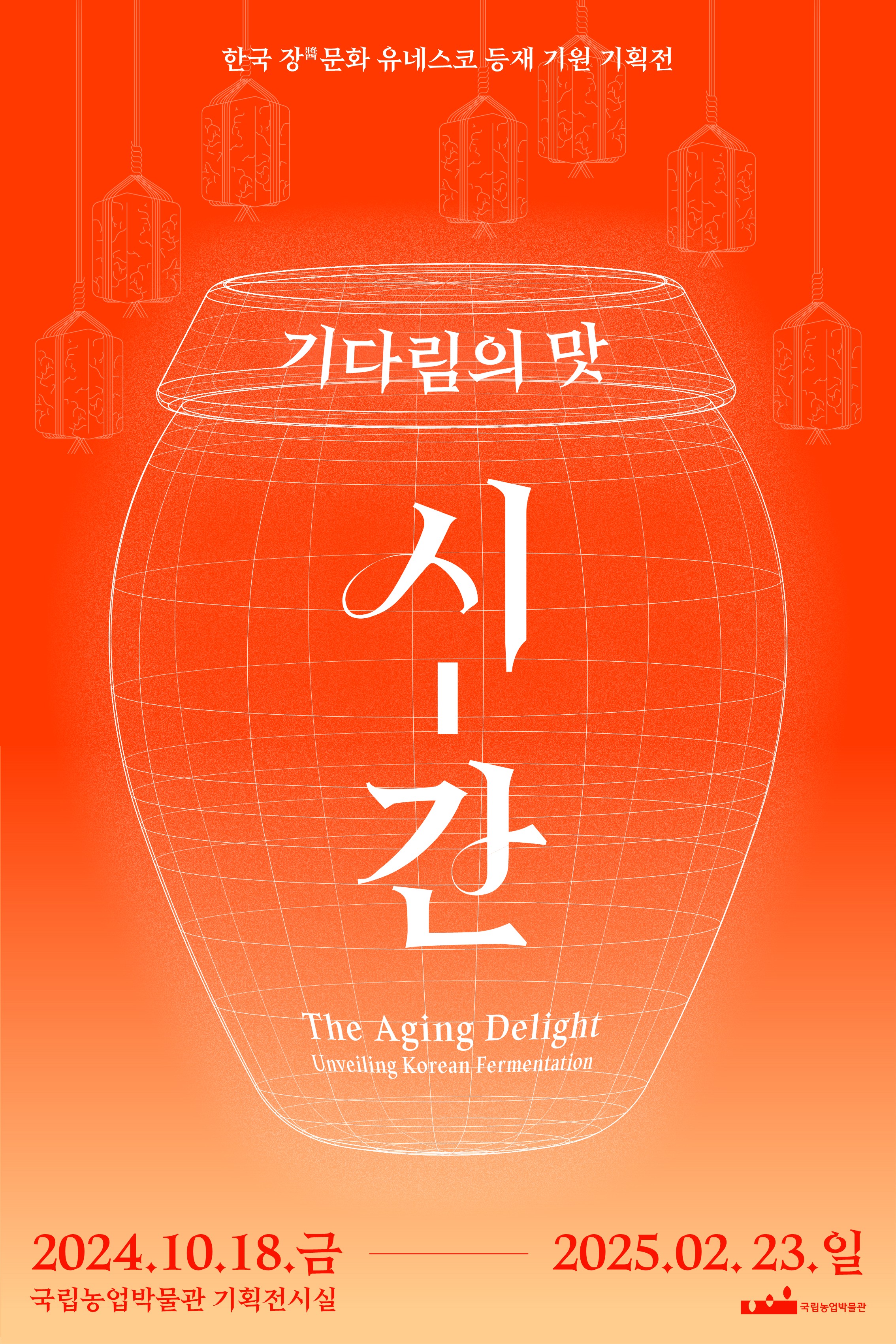-
2024 국립농업박물관 하반기 기획전
2024 국립농업박물관 하반기 기획전
-
- 기간
- 2024. 10. 18.(금)~2025. 2. 23.(일)
-
- 장소
- 국립농업박물관 기획전시실
-
- 문의
- 031-324-0765
- 수정일
- 2025.10.22
- 작성자
- 전시팀2
- 조회수
- 4353
- 등록일
- 2024.10.14

2024 국립농업박물관 하반기 기획전
<기다림의 맛, 시_간> The Aging Delight: Unveiling Korean Fermentation
국립농업박물관에서는 한국 '장(醬)문화' 유네스코 인류무형유산 등재를 기원하며 이번 하반기 기획전을 마련하였습니다.
인류는 시간의 흐름에 따라 음식을 준비하고 기다리는 과정에서 새로운 문화를 형성했습니다.
추수와 저장, 발효는 인류가 자연과 조화를 이루며 생명을 지켜나가는 지혜를 담아낸 방식이었습니다.
특히 간장, 된장, 고추장 등 발효 음식은 우리의 맛을 한층 더 건강하고 다채롭게 만들어 주었습니다.
세계적으로 슬로우푸드에 대한 관심이 커지면서 기다림이 필요한 우리 발효 음식의 가치와 중요성이 다시 한번 주목받고 있습니다.
이번 전시는 우리 ‘장(醬)문화’의 유네스코 인류무형문화유산 등재를 바라보며, 기록과 문헌을 바탕으로 장에 대한 역사성과 전통성을 되짚어 보고자 합니다.
전시를 통해 장문화에 담긴 기다림의 맛과 미래의 가치를 발견하고 발효로 완성되는 정성스러운 음식 문화를 되새기는 시간이 되길 바랍니다.
[1부, '장(醬)'의 과거를 보다]
우리나라 사람들은 예로부터 콩을 발효시켜 메주로, 그 메주를 또 한 번 발효시켜 ‘장(醬)’으로 만들어 먹는 방식으로 식문화를 발전시켰습니다.
메주를 어떻게 만들고 발효시키는지에 따라 장의 맛과 깊이가 달라 우리 선조들은 메주를 만들 때 아주 신중하였고 정성을 다했습니다.
이러한 과정은 단순히 식품을 만드는 것을 넘어 시간이 지남에 따라 맛과 향이 깊어지는 복합적인 예술을 의미하게 되었습니다.
[2부, 생명을 만들다]
우리 옛 집은 부엌과 가장 가까운 곳에 장독대를 두었습니다.
장독대를 가득 채운 옹기는 발효 음식을 저장하는 그릇으로 음식이 썩지 않고 발효가 되도록 도와 그 자체로서 발효 과정에 중요한 역할을 합니다.
이때 숨 쉬는 그릇, 옹기 속에는 무슨 일이 일어나고 있을까요?
햇볕이 잘 들고 바람이 잘 통하는 곳에서 옹기는 물, 공기, 온도 등 자연과 교감하며 메주의 미생물을 키워내고 맛있게 숙성하여 우리 음식에 주요 양념이 되는 간장, 된장, 고추장을 탄생시킵니다.
[3부, 과거부터 미래를 먹다]
발효 음식에 대한 효능이 입증됨에 따라 한식에 대한 관심이 증가하고 있습니다.
한류와 K-푸드에 대한 관심이 높아진 시대의 흐름 속에서 우리 장문화의 유네스코 인류무형문화유산 등재를 통해 우리만의 ‘향’과 ‘맛’이 담긴 한국 식문화의 위상이 높아지기를 바랍니다.
또한 과거의 경험과 현대의 기술이 결합하여 우리의 독특한 장(醬)문화의 가치와 지혜를 지속하여 만들어 갈 미래 역시 기대해봅니다.
[Introduction]
Humans have formed new cultures through the processes of preparing and waiting for food over the flow of time.
Harvesting, storing, and fermenting are wise strategies for humans to support a life in harmony with nature. In particular, fermented ingredients, such as soy sauce (ganjang), fermented soybean paste (doenjang), and red chili paste (gochujang), have made Korean dishes healthier and more colorful.
As global interest in slow food grows, the value and importance of our Korean fermented foods, which require long waits, are once again in the spotlight.
This exhibition aims to reflect on the historical and traditional aspects of our “jang”(fermented sauces) culture, with a view toward its registration as a UNESCO Intangible Cultural Heritage.
Through this exhibition, we hope to discover the taste of waiting inherent in jang culture, explore its future value, and appreciate the dedication that completes our culinary culture through fermentation.
[Part 1. The Past of Korean Traditional Sauces (Jang)]
Koreans have developed a food culture by fermenting soybeans into blocks of fermented soybeans, and then using those blocks for further fermentation to create Korean traditional sauces (jang).
The taste and depth of traditional sauces vary depending on how the blocks of fermented soybeans are made and fermented.
Our ancestors approached the making of these blocks with great care and dedication.
This process is part of food production and represents a complex art through which flavors and aromas deepen over time.
[Part 2. Creating a Microbiome]
In old Korean houses, there was an earthenware jar stand (jangdokdae) located close to the kitchen.
The jars themselves are essential to the fermentation process, helping to preserve food and prevent spoilage.
What occurs inside these breathing jars is crucial to the fermentation process. In a spot with ample sunlight and good airflow, the jars interact with elements of nature, including water, air, and temperature.
This interaction nurtures the microorganisms in the blocks of fermented soybeans, allowing them to age beautifully and ultimately producing essential seasonings for our cuisine: soy sauce, doenjang (fermented soybean paste), and gochujang (red chili paste).
[Part 3. Eating from the Past to the Future]
An interest in Korean fermented foods has been growing thanks to their proven health benefits. In this era of rising interest in the Korean Wave and K-food, we hope that Korean traditional sauces will elevate the status of Korean culinary culture, imbued with our unique “flavors” and “aromas,” through the UNESCO Intangible Cultural Heritage designation.
We also look forward to a future where the value and wisdom of our distinctive jang culture continue to thrive through the combination of past experiences and modern technology.
<기다림의 맛, 시_간>
ㅇ전시기간: 2024. 10. 18.(금)-2025. 2. 23.(일)
ㅇ전시장소: 국립농업박물관 기획전시실
ㅇ관람시간: 화~일요일 10:00~18:00
ㅇ전 시 품: 고구려 항아리, 추사 김정희 간찰, 메주틀 스피커 작품 Ferment, 조정숙 명인 장석 항아리 등 유물 및 사진·영상 자료
ㅇ관 람 료: 무료
ㅇ관련문의: 국립농업박물관 전시팀(031-324-0765)
- 기간
- 2024. 10. 18.(금)~2025. 2. 23.(일)
- 장소
- 국립농업박물관 기획전시실
- 문의
- 031-324-0765